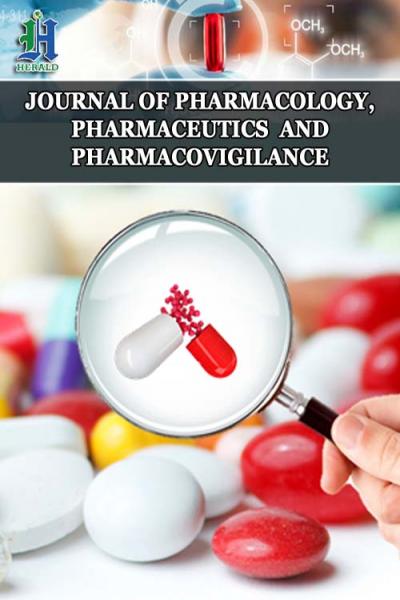
In -Vivo Neuropharmacological and In-Silico Study with GABA & 5-HT to Discover Potent Anxiolytic Compound from Clerodendrum viscosum Vent. (Family: Verbenaceae)
*Corresponding Author(s):
Md. Shahidul IslamDepartment Of Pharmacy, University Of Science & Technology Chittagong (USTC), Chattogram, Bangladesh
Tel:+88 01815 579040,
Email:s_i_liton@yahoo.com
Abstract
There is a raising focus on significance of the medicinal plants in addition to traditional plants healthiness systems in resolving the healthcare crisis of the globe. In this research work in-vivo neuropharmacological study which performed by open field and hole cross test with albino mice shows that the methanolic extract of Clerodendrum viscosum has moderate Central Nervous System (CNS) depressant activity. It also increases significantly Phenobarbital (45 mg/kg) induced onset of sleeping time and duration of sleeping time in mice for Clerodendrum viscosum is 12.88 mins, 11.4 mins and 104.2, 135.8 mins for 250 mg and 500 mg dose respectively. The effect of Clerodendrum viscosum extract on Aminophylline (280mg/kg) induced convulsion in mice has raised the threshold of seizure and exerted a statistically significant dose dependent delay on the onset of clonic and tonic convulsion for 250 mg and 500mg is 14.04, 39.824 and 14.6, 48.74 respectively when compared to control and in case of standard drug; diazepam (2mg/kg),the effect is minimal than the control. From In-silico pharmacological study it has been observed that the anxiolytic activity of Clerodendrum viscosum may be due to Scutellarin and Xylitol which has been found from their gliding energy with Gamma-Aminobutyric Acid (GABA) (PDB id: 4COF) -50.78, -27.211 respectively and due to Scutellarin, Xylitol and 3-Deoxy-d-mannoic lactone with 5-HT (PDB id: 4IAR) the gliding energy is -49.52, -25.185, -29.397 respectively which predicts that these compound may have potential anxiolytic activity. Taken all together, the present study demonstrates that methanolic extracts of Clerodendrum viscosum shows significant Central Nervous System (CNS) depressant activity as well as anxiolytic activity which is comparable to standard (Diazepam). From In-Silico Pharmacological study it is observed that the anxiolytic activity of Clerodendrum viscosum may be due to Scutellarin, Xylitol and 3-deoxy d-mannoic lactone either alone or synergistic effect of two or more compound interactions. So, for the molecular interaction analysis such as Scutellarin and Xylitol. Molecular docking with GABA glide score was presented as a method in this research.
Keywords
Clerodendrum viscosum; GABA (PDB id: 4COF); 5-HT (PDB id: 4IAR); Neuropharmacology.
INTRODUCTION
The plant that have therapeutic actions or wield beneficial pharmacological outcomes on animal bodies are usually assigned as “Medicinal Plants”. While there is no perceptible morphological property in medicinal plants producing with them, so far, they have several special qualities that create them medicinally so important. Over the last few decades, use of herbal drugs has been emphasized due to their easy availability, therapeutic potential, least side effects and minimum cost. At present nearly 80% of the world population relies on plant-based drugs for their health care need. Presently, phytoconstituents are playing pivotal role for development of novel compounds, which might be crucial for maintaining a healthy society [1]. The human civilization has been maintaining an intimate relationship with the plants from time immemorial. They depend on plants and other natural sources for their well?being and survival. Various plants still available in the nature are yet to be explored for their medicinal potential [2]. Uses of computational chemistry to discover, enhance, or study drugs and related biologically active molecules. The most fundamental goal is to predict whether a given molecule will bind to a target and if so, how strongly. Molecular mechanics or molecular dynamics are most often used to predict the conformation of the small molecule and to model conformational changes in the biological target that may occur when the small molecule binds to it [3].
MATERIALS AND METHODS
Collection and preparation of leaf extract
The plant leaves Clerodendrum viscosum were collected at their fully mature form, from Foy’z lake hill tracts, Chittagong, Bangladesh. The plant samples were identified by Dr. Sheik Bakttier, Chittagong University, Bangladesh. Leaves of Clerodendrum viscosum were carefully separated, cleaned, shade dried, mechanically grinded and coarsely powdered. About 100 gm of air-dried powdered material was extracted with 98.5% methanol in a Soxhlet extractor for 30 hours. It was concentrated to dryness under reduced pressure and controlled temperature (40-50ºC) using rotary evaporator. The methanolic extract yielded a green Sticky mass weighing 100 gm. The methanolic extract was concentrated by vacuum distillation to dryness; the yield obtained was 12.5% w/w with respect to dried leaf. The collected leaf extract was stored in a desiccator. The aim of the present study is to find out if the extract had any effect on central nervous system. In addition, this study performed to discover potent anxiolytic compound from Clerodendrum viscosum.
Drugs and chemicals
All the chemicals and solvents used in this study were of analytical grade and standards drug diazepam were obtained from Square Pharmaceuticals Ltd.
Experimental animal
Young Swiss albino mice of either sex, weighing between 20-25 gm, were collected from Animal Research Branch of BCSIR. Animals were maintained under standard environmental conditions [(27.0 ±1.0) °C, relative humidity (55-65) % and 12 h light/12 h dark cycle] and free access to feed and water ad libitum. Prior to experimentation, the animals were acclimatized to laboratory condition for one week. All protocols for animal experiment were approved by the Institutional Ethics Committee [4].
In vivo neuropharmacological study
Neuropharmacology is the study of how drugs affect cellular function in the nervous system, and the neural mechanisms through which they influence behavior. For the neuropharmacology tests it takes four different studies. They are (1) Open field method, (2) Hole cross method, (3) Prolongation Effect on Phenobarbital Induced Sleeping Time in Mice, (4) Aminophylline Induced Convulsion in Mice.
Open field test
In open field test, the animals were divided into control, positive control, and test groups containing five mice each. The test groups received extracts (100, 200 mg/kg) body weight orally whereas the control group received saline water. Like hole cross test, animals in positive control group received diazepam (1 mg/kg). The floor of an open field of half square meter was divided into a series of squares each alternatively colored black and white. The apparatus had a wall of 40 cm height. The number of squares visited by the animals was counted for 3 min at 0, 30, 60, 90, and 120 min after oral administration of the test drugs and the standard [5].
Hole-cross test
A wood partition was fixed in the middle of a cage having a size of 30 × 20 × 14 cm. A hole of 3 cm diameter was made at a height of 7.5 cm in the Centre of the cage. The animals were divided into control, positive control, and test groups containing five mice each. The test groups received extracts at the doses of (100,200 mg/kg) body weight orally whereas the vehicle control and positive control groups received vehicle due to observe variation and the standard drug diazepam (1 mg/kg) respectively. The number of passages of a mouse through the hole from one chamber to other was counted for a period of 3 min at 0, 30, 60, 90 and 120 min after oral administration of the test drugs and the standard [6].
Prolongation effect on phenobarbital induced sleeping time in mice
Eighteen male Swiss albino mice (20-28 g) were randomly divided into 3 groups (n = 6). Group I received phenobarbital (45 mg/kg b.w; i.p.) and served as phenobarbital control. Group II and III received MECV (250 and 500 mg/kg b.w; i.p.) 30 min prior to the administration of phenobarbital (45 mg/kg b.w; i.p.). The time between the loss of the righting reflex and the regain of this reflex measured as the sleeping time [7].
Aminophylline induced convulsion in mice
Clerodendrum viscosum extract was evaluated for activity against aminophylline – induced convulsion. The adult Swiss albino mice were divided into four groups of six animals each. Group 1 received normal saline. Group 2 received diazepam 2 mg/kg one hour before induction of convulsion. Groups 3 and 4 received Clerodendrum viscosum 250 and 500 mg/kg p.o. respectively. The seizure was induced using aminophylline (280 mg/kg) [8].
In silico techniques
In silico techniques are developed particularly as an alternative to animal experimentation. This technique may be better alternatives for the drug and chemical testing, with reduced animal use up to some levels, since with the help of such software programs we can tailor make a new drug for the specific binding site and then in final stage animal testing is done to obtain confirmatory results [9].
Collection and preparation of ligand
The structure of Phyto-constituents of Clerodendrum viscosum were collected from (Goutam Ghosh et. al /articles/PMC4285639) related drug molecules from PubChem database was downloaded from (https://pubchem.ncbi.nlm.nih.goc). From this database comprise 12 bioactive compounds from Clerodendrum viscosum. Their ionization states were generated at pH 7.0±2.0 using default settings of Epik2.2 in Schrödinger Suite v11.2 Up to 32 possible stereoisomers per ligand was retained. This collected structures (ligands) prepared for further analysis [10,11].
Selection of desired ligand
The drug-like activity of the ligand molecules was categorized using ADME properties by QikProp module of Schrodinger Suit v11.2. The selected properties are known to influence metabolism, cell permeation, and bioavailability. QikProp generates physically relevant descriptors and uses them to perform ADMET predictions [12].
Preparation of receptor
The Crystal structure of a human gamma-aminobutyric acid receptor, the GABA (A) R-beta3 homopentamer (PDB id: 4COF) and crystal structure of the chimeric protein of 5-HT1B-BRIL in complex with ergotamine (PSI Community Target) (PDB id: 4IAR) downloaded from the protein data bank. Structure was prepared and refined using the Protein Preparation Wizard of Schrödinger-Maestro v11.2. Reorientation of certain group was optimized at neutral pH. Using force field OPLS_2005, minimization was carried out setting maximum heavy atom RMSD to 0.30 Å. Then the protein structure was prepared by the removal of water atoms and unnecessary residues [13,14].
Molecular Docking
The docking has been carried out by the application of Schrödinger software suite. To prepare protein for docking and simulation, initial step is setup protein grid. This grid represents pre-calculated properties of protein such as assign bond orders, add hydrogen bond, create disulfide bonds and fill missing side chains and loops. The grid is generated to enclose the expected binding region. An energy minimization performed to find out best scoring pose that is geometrically similar to the input pose. The glide or docking scores will be displayed in text document. Thus, the ligand which has the least glide score will be considered to have the best glide score or docked pose [15].
RESULTS AND DISCUSSION
Open field method
In the search of in vivo neuro pharmacological activity of methanolic extract of Clerodendrum viscosum we have started our research with open field test and hole-cross and hole cross test instinctive locomotor effect. The result was presented on table 1. From the result it is significant that increased in dose show slight decreased in locomotor activity of mice, which are evident for depressant activity of the extract.
|
Minutes |
Control |
Diazepam |
Cl.viscosum |
Cl.viscosum |
|
|
(100mg) |
(200mg) |
||
|
|
|
|
||
|
Open Field Method |
|
|
|
|
|
0 |
4 |
2.6 |
2.8 |
2.9 |
|
30 |
3.6 |
2 |
3.5 |
2.7 |
|
60 |
3.2 |
1 |
2.8 |
2.6 |
|
90 |
3.8 |
0.6 |
2 |
1.8 |
|
120 |
3.4 |
0.4 |
1.8 |
1.02 |
|
Hole-cross Test |
|
|
|
|
|
0 |
96 |
79 |
91 |
71 |
|
30 |
77 |
56.2 |
68 |
42.6 |
|
60 |
69.7 |
27.8 |
42.6 |
35.2 |
|
90 |
56.6 |
19.2 |
38.9 |
29.4 |
|
120 |
54.8 |
11 |
35.2 |
21.8 |
Table 1: Neuro pharmacological activity test of methanolic extract of leaves of Cl.viscosum by open field and hole-cross method.
Hole-cross test
The result was represented in table 1. From the table it was seen that this extract shows moderate neuro pharmacological activity on mice. Overall open field test and hole-cross test results obtained from this study suggested that, the methanolic extract of Cl. viscosum has moderate CNS depressant activity on experimental animal models.
Prolongation effect on phenobarbital induced sleeping time in mice
The result from the prolongation effect on phenobarbital induced sleeping time in mice is presented on table 2. The study was undertaken to evaluate the sleep potentiating effect of MECV (250 and 500 mg/kg b.w; i.p.) in mice and the extract significantly increased Phenobarbital (45 mg/kg b.w; i.p.)-induced sleeping time in a dose dependent manner.
|
Treatment |
Dose (mg/kg) |
Onset of Sleep in Minutes |
Duration of Sleep in Minutes |
|
Phenobarbital 45mg/kg |
45 |
2.5 |
82 |
|
MECV 250mg/kg |
250 |
12.88 |
104.2 |
|
MECV 500mg/kg |
500 |
11.4 |
135.8 |
Table 2: Neuro pharmacological activity Cl.viscosum leaves extract on phenobarbital induced sleeping time in mice.
Aminophylline induced convulsion in mice
The CNS depressant activity of Cl.viscosum leaves extract was confirmed upon on the aminophylline induced convulsion treatment of the animal with the plant extract in table 3. The result shows that the effect of Clerodendrum viscosum extract on aminophylline induced convulsion in mice. The extract (250mg-500mg) raised the threshold of seizure and exerted a statistically significant dose dependent delay on the onset of clonic and tonic convulsion when compared to control and this was short compared to that of the standard drug diazepam (2mg/kg).
|
Treatment(mg/kg) |
Latency of clonic convulsion |
Latency of tonic convulsion |
Time of death (mins) |
Mortality% |
|
|
|
|||
|
Control |
6.78 |
7.84 |
8.6 |
100 |
|
Diazepam |
3.5 |
49 |
109.66 |
100 |
|
MECV250mg |
14.06 |
39.82 |
65.12 |
100 |
|
MECV500mg |
14.4 |
48.74 |
89.48 |
100 |
Table 3: Neuro pharmacological activity Cl.viscosum leaves extract on aminophylline induced convulsion in mice.
ADMET and drug linkage properties of selected ligands
In silico ADMET analysis identify favorable compounds to be used as human therapeutic agents and molecular descriptors are the deciding factors of a compounds for pharmacokinetics properties and toxicity All 12 bioactive compounds from Cl. viscosum analyzed with ADMET related properties (Table 4), among which were molecular weight, H-bond donor, H-bond acceptor, human oral absorption, CNS, octanol/water partition coefficient and total solvent accessible area were calculated by QikProp program. In the determination of predicted nervous system activity compounds which are in the range between -2 to +2 scales have significant CNS depressant effect.
|
Number |
Ligand |
Molecular weight |
H-bond donor |
H-bond acceptor |
Human Oral Absorption % |
CNS |
Qplog Po/w |
SASA |
|
1 |
1,3-Methylene-d-arabitol |
164.158 |
3 |
8.5 |
70.361 |
-1 |
-1.182 |
316.858 |
|
2 |
Xylitol |
152.147 |
5 |
8.5 |
57.384 |
-2 |
-1.704 |
335.374 |
|
3 |
Hispidulin-7-O-glucuronide |
300.267 |
2 |
4.5 |
78.033 |
-2 |
1.867 |
521.099 |
|
4 |
Scutellarin |
462.366 |
5 |
9.5 |
0 |
-2 |
-0.239 |
659.99 |
|
5 |
5-Hydroxymethylfurfural |
126.112 |
1 |
4.2 |
73.882 |
-1 |
-0.176 |
317.742 |
|
6 |
3-Deoxy-d-mannoic lactone |
162.142 |
3 |
8.1 |
57.69 |
-2 |
-1.532 |
331.739 |
|
7 |
Orcinol |
124.139 |
2 |
1.5 |
84.602 |
0 |
0.803 |
322.449 |
|
8 |
Acetamide |
144.13 |
0 |
2 |
69.245 |
-1 |
0.127 |
349.602 |
|
9 |
2,4-Dihydroxy-5,6-dimethylpyrimidine |
140.141 |
2 |
3.5 |
71.752 |
-1 |
-0.231 |
320.086 |
|
10 |
Glycerol |
92.094 |
3 |
5.1 |
71.327 |
-1 |
-0.988 |
252.307 |
|
11 |
2(1H) Pyrimidinone,1-methyl- |
110.115 |
0 |
3.5 |
83.629 |
0 |
-0.166 |
294.697 |
|
12 |
N hexadecanoic acid |
256.428 |
1 |
2 |
88.061 |
-2 |
5.252 |
664.882 |
Table 4: Details of ligands with ADMET properties.
Molecular docking with GABA
Molecular docking is a combination of both molecular dynamics and molecular docking, predicts accurately receptor natural conformation changes and ligand binding modes. Accordingly, the top 2 were selected for the molecular interaction analysis such as Scutellarin and Xylitol. Molecular docking with GABA glide score presented on table 5.
In order to study the interaction between GABA and the ligand scutellarin (Figure 1) demonstrates a strong favorable bond. Major residues like VAL 50, GLU 52, TYR 143, TYR 220, THR 271 significant H-bonding between them.
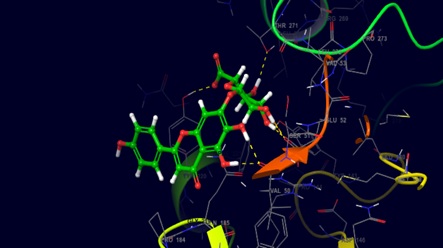 Figure 1: Scutellarin_GABA_3D.
Figure 1: Scutellarin_GABA_3D.
Also, ligand Xylitol interaction with GABA (Figure 2) represents strong bond including major residues GLU 52, TYR 143, TYR 220, GLN 185, THR 271 significant H-bonding between them.
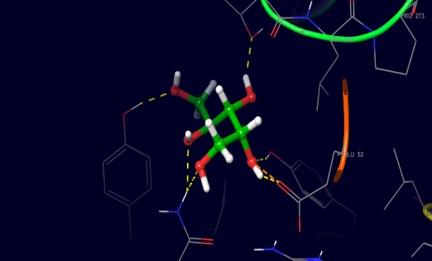 Figure 2: Xylitol_GABA_3D.
Figure 2: Xylitol_GABA_3D.
Molecular docking with 5-HT
The molecular docking between ligands with 5-HT receptor is representing in table 5. Thus top 3 ligands such as Scutellarin, Xylitol and 3-Deoxy-d-mannoic lactone show significant glide docking scores in the evaluation of potent anxiolytic compound.
|
Name of the compound |
Docking score |
Glide score |
Glide energy |
|
GABA |
|
|
|
|
Scutellarin |
-8.255 |
-8.259 |
-50.78 |
|
Xylitol |
-5.137 |
-5.137 |
-27.211 |
|
5-HT |
|
|
|
|
Scutellarin |
-9.651 |
-9.655 |
-49.562 |
|
Xylitol |
-5.452 |
-5.452 |
-25.185 |
|
3-Deoxy-d-mannoic lactone |
-5.356 |
-5.356 |
-29.397 |
Table 5: Molecular docking and binding energy analysis with GABA and 5- HT.
In order to study the interaction between 5-HT and the ligand scutellarin (Figure 3) demonstrates a poor bonding in comparison with GABA. Major residues like TYR110, THR355, ASP252, ASP129 binds with H-bond.
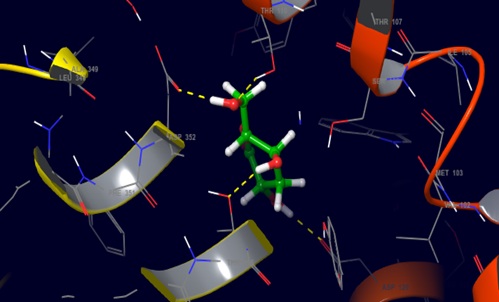 Figure 3: Scutellarin_5-HT_ 3D.
Figure 3: Scutellarin_5-HT_ 3D.
Here the interaction between 5-HT and the ligand Xylitol (Figure 4) demonstrates strong favorable bond. Major residues like ASP352, TYR359, TYR110, THR110 ASP129 binds significantly with h-bond.
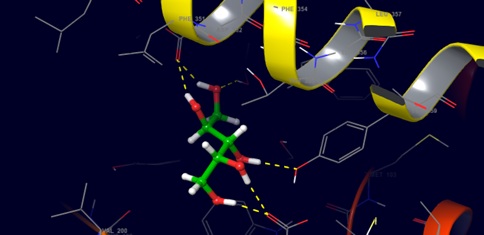 Figure 4: Xylitol_5-HT_ 3D.
Figure 4: Xylitol_5-HT_ 3D.
In other content the interaction between 5-HT and the ligand 3-Deoxy-d-mannoic lactone (Figure 5) demonstrates poor bond. Major residues like ASP129, ASP352, THR271, THR110 binds with H-bond.
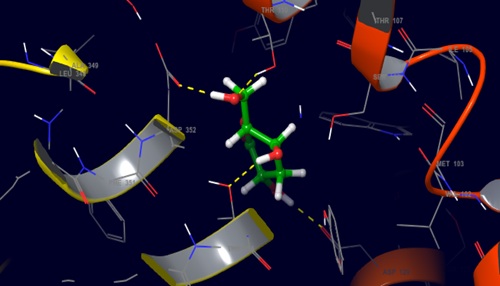 Figure 5: 3-Deoxy-d-mannoic lactone_5-HT_3D.
Figure 5: 3-Deoxy-d-mannoic lactone_5-HT_3D.
CONCLUSIONS
In this research study, the result shows that the effect of Clerodendrum viscosum extract on aminophylline induced convulsion in mice. the extract(250mg-500mg) raised the threshold of seizure and exerted a statistically significant dose dependent delay on the onset of clonic and tonic convulsion when compared to control and this was short compared to that of the standard drug diazepam(2mg/kg). From above study, In-Vivo Neuropharmacological study methanolic extract of Clerodendrum viscosum (Family: Verbenaceae) shows significant CNS depressant activity as well as anxiolytic activity which is comparable to standard (Diazepam). In-Silico Pharmacological study it is observed that the anxiolytic activity of Clerodendrum viscosum may be due to Scutellarin has good binding affinity with GABA receptor rather than 5-HT. But Xylitol shows moderate binding affinity with GABA and as well as 5-HT. Here the interaction between 5-HT and the ligand Xylitol demonstrates a strong favorable bond. Major residues like ASP352, TYR359, TYR110, THR110, ASP129 binds significantly with H-bond.
REFERENCES
- Das JK, Kandar C, Dey SP, Mandal SC (2011) Evaluation of Analgesic Activity of Clerodendrum Viscosum (Verbenaceae) Leaves on Experimental Animal Model. Int J of Pharma & Biosciences 2: 345-349.
- Sermakkani M, Thangapandian V (2012) GC-MS analysis of Cassia Italica leaf methanol extract. Asian J Pharm Clin Res 5: 90-94.
- Shil S, Choudhury MD, Das S (2014) Indigenous knowledge of medicinal plants used by the Reang tribe of Tripura state of India. J Ethnopharmacol 152: 135-141.
- Zimmermann M (1983) Ethical guidelines for investigations of experimental pain in conscious animals. Pain J 16: 109-110.
- Barros HMT, Tannhauser MAL, Tannhauser SL, Tannhauser M (1991) Enhanced detection of hyperactivity after drug withdrawal with a simple modification of the open-field apparatus. J Pharmacol Meth 26: 269-275.
- Hosseinzadeh H, Shahandeh S, Shahsavand S (2012) Anxiolytic and Hypnotic Effects of Aqueous and Ethanolic Extracts of Aerial Parts of Echium italicum in Mice, Jundishapur. J Nat Pharm Prod 7: 71-79.
- Sudipta (2010) Anticonvulsant activity of methanolic extract of Clerodendrum infortunatum in Swiss albino mice. Thai J Pharm Sci 34 129-133.
- Udobang JA, Okokon JE, Ettebong EO (2017) Anticonvulsant effect of ethanol root extract of Setaria megaphylla (Steud) T. Dur and Schinz in Mice. World journal of pharmaceutical research 6: 130-137.
- Mishra BB, Tiwari VK (2011) Natural products: an evolving role in future drug discovery. European journal of med chem 46: 4769-4807.
- Ghosh G, Panda P, Rath M, Pal A, Sharma T, et al. (2015) GC-MS analysis of bioactive compounds in the methanol extract of Clerodendrum viscosum Pharmacognosy Res 7: 110-113.
- Sastry GM, Adzhigirey M, Day T, Annabhimoju R, Sherman W (2013) Protein and ligand preparation: parameters, protocols, and influence on virtual screening enrichments. Journal of computer-aided molecular design 27: 221-234.
- Pawar VS, Lokwani DK, Bhandari SV, Bothara KG, Chitre TS, et al. (2011) Design, docking study and ADME prediction of Isatin derivatives as anti-HIV agents. Medicinal chemistry research 20: 370-380.
- Miller PS, Aricescu AR (2010) Crystal structure of a human GABAA receptor. Nature 510: 134-145.
- Hoyer D (1994) International Union of Pharmacology classification of receptors for 5 hydroxytryptamine (Serotonin). Pharmacol Rev 46: 157-245.
- Bhachoo J, Beuming T (2017) Investigating Protein–Peptide Interactions Using the Schrödinger Computational Suite. In Modeling Peptide-Protein Interactions 1561: 235-254.
Citation: Siddiki AK, Abeda T, Islam S (2020) In -Vivo Neuropharmacological and In-Silico Study with GABA & 5-HT to Discover Potent Anxiolytic Compound Fhmirom Clerodendrum viscosum Vent. (Family: Verbenaceae). J Pharmacol Pharmaceut Pharmacovig 4: 016.
Copyright: © 2020 Md. Abdul Kaium Siddiki, et al. This is an open-access article distributed under the terms of the Creative Commons Attribution License, which permits unrestricted use, distribution, and reproduction in any medium, provided the original author and source are credited.
